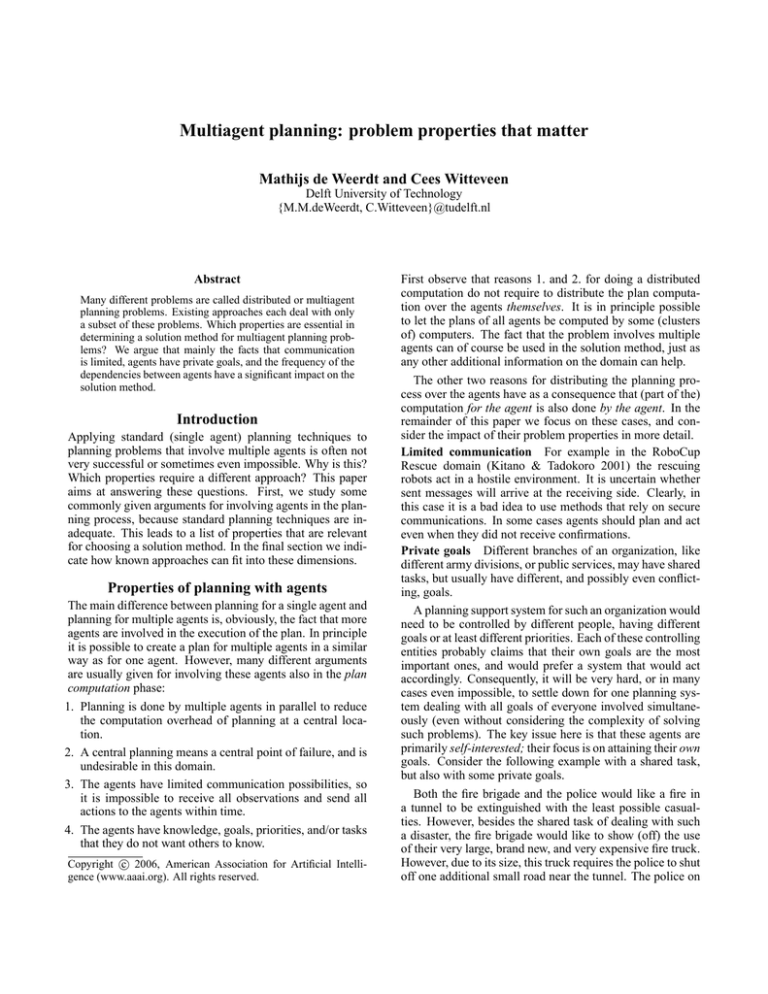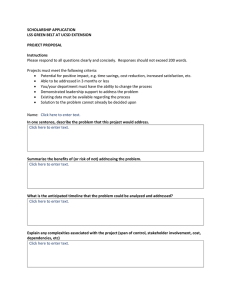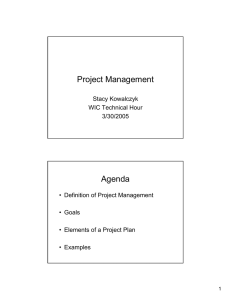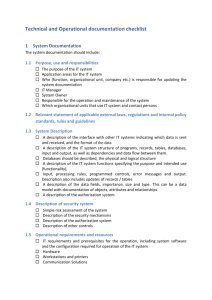
Multiagent planning: problem properties that matter
Mathijs de Weerdt and Cees Witteveen
Delft University of Technology
{M.M.deWeerdt, C.Witteveen}@tudelft.nl
Abstract
Many different problems are called distributed or multiagent
planning problems. Existing approaches each deal with only
a subset of these problems. Which properties are essential in
determining a solution method for multiagent planning problems? We argue that mainly the facts that communication
is limited, agents have private goals, and the frequency of the
dependencies between agents have a significant impact on the
solution method.
Introduction
Applying standard (single agent) planning techniques to
planning problems that involve multiple agents is often not
very successful or sometimes even impossible. Why is this?
Which properties require a different approach? This paper
aims at answering these questions. First, we study some
commonly given arguments for involving agents in the planning process, because standard planning techniques are inadequate. This leads to a list of properties that are relevant
for choosing a solution method. In the final section we indicate how known approaches can fit into these dimensions.
Properties of planning with agents
The main difference between planning for a single agent and
planning for multiple agents is, obviously, the fact that more
agents are involved in the execution of the plan. In principle
it is possible to create a plan for multiple agents in a similar
way as for one agent. However, many different arguments
are usually given for involving these agents also in the plan
computation phase:
1. Planning is done by multiple agents in parallel to reduce
the computation overhead of planning at a central location.
2. A central planning means a central point of failure, and is
undesirable in this domain.
3. The agents have limited communication possibilities, so
it is impossible to receive all observations and send all
actions to the agents within time.
4. The agents have knowledge, goals, priorities, and/or tasks
that they do not want others to know.
c 2006, American Association for Artificial IntelliCopyright gence (www.aaai.org). All rights reserved.
First observe that reasons 1. and 2. for doing a distributed
computation do not require to distribute the plan computation over the agents themselves. It is in principle possible
to let the plans of all agents be computed by some (clusters
of) computers. The fact that the problem involves multiple
agents can of course be used in the solution method, just as
any other additional information on the domain can help.
The other two reasons for distributing the planning process over the agents have as a consequence that (part of the)
computation for the agent is also done by the agent. In the
remainder of this paper we focus on these cases, and consider the impact of their problem properties in more detail.
Limited communication For example in the RoboCup
Rescue domain (Kitano & Tadokoro 2001) the rescuing
robots act in a hostile environment. It is uncertain whether
sent messages will arrive at the receiving side. Clearly, in
this case it is a bad idea to use methods that rely on secure
communications. In some cases agents should plan and act
even when they did not receive confirmations.
Private goals Different branches of an organization, like
different army divisions, or public services, may have shared
tasks, but usually have different, and possibly even conflicting, goals.
A planning support system for such an organization would
need to be controlled by different people, having different
goals or at least different priorities. Each of these controlling
entities probably claims that their own goals are the most
important ones, and would prefer a system that would act
accordingly. Consequently, it will be very hard, or in many
cases even impossible, to settle down for one planning system dealing with all goals of everyone involved simultaneously (even without considering the complexity of solving
such problems). The key issue here is that these agents are
primarily self-interested; their focus is on attaining their own
goals. Consider the following example with a shared task,
but also with some private goals.
Both the fire brigade and the police would like a fire in
a tunnel to be extinguished with the least possible casualties. However, besides the shared task of dealing with such
a disaster, the fire brigade would like to show (off) the use
of their very large, brand new, and very expensive fire truck.
However, due to its size, this truck requires the police to shut
off one additional small road near the tunnel. The police on
the other hand is interested in minimizing the number of required officers assigned to the tunnel disaster to be able to
still assign some to the stadium, where an important baseball
game is taking place at the same time.
When multiple companies are involved in one task (e.g.,
from a supply chain to selling the goods), situations with private goals are even easier to see, because in principle, each
company is mainly interested in maximizing its own profits.1
When agents have private goals, a whole set of other properties are relevant to determine applicable solution techniques.
Conflicting goals When agents have private goals, it is not
trivial to find out whether some of their goals are conflicting.
Which goals should be attained and which not? We believe
that this should be the result of some negotiation process between these agents. Whenever agents have private goals they
usually cannot send each other details of their plans. So in
that case we need some method of coming to an agreement
between agents anyhow. Whether goals are conflicting then
only makes a marginal difference.
Dependencies between agents A dependency between
agents arises when one agent needs others to fulfill a subtask, or when the agents can only fulfill a task if they act
on it together, or when one agent needs to wait for others
to finish occupying a resource (Malone & Crowston 1994).
If (parts of) plans may be exchanged it is straightforward
to check the plans of the agents for deadlocks. But what if
goals, and thus plans, need to be kept private?
The types of tasks and the abilities of the agents determine the number of dependencies between agents. Problems with many dependencies require much more coordination and thus communication between the agents.
Shared tasks Whether a problem includes agents that
have shared tasks or goals is strongly related to the property
of dependencies between agents. Suppose we have a method
that deals with tasks assigned to one responsible agent. Such
a method can be adapted to deal with tasks shared among
a group of agents as well, by assigning the task to every
agent, and introducing dependencies between all agents in
this group.
Dynamism Plans executed in the real world need to be
adapted continuously, because of incidents, or just as more
information becomes available. Consequently planning
agents need to be able to deal with such changes. In a multiagent planning system, agents deal with changes all the time,
because of other agents’ plans. Therefore, the dynamicity of
the domain does not make a significant difference.
Summary Some of the properties discussed above have
only a minor impact on the potential solution methods.
Leaving those ones out, we remain with the following important dimensions of multiagent planning problems.
1. Limited communication
2. Private goals: ranging from completely opposite goals to
different priorities of shared tasks
1
Note that in some cases it may even be that one agent has a
goal of obstructing another agent as much as possible.
3. Dependencies between agents: ranging from strongly interdependent to (almost) independent
Obviously, these dimensions are a bit fuzzy, but they illustrate the diverse kinds of problems we are trying to solve.
Conclusions
We argue that only three problem properties have a significant impact on the solution methods that can be used for
a multiagent planning problem. Firstly, when communication is limited, agents should not wait for commitments before acting. Secondly, when agents have private goals, it
is not advisable to exchange parts of plans, and commitments should be made through some form of negotiation
process. And thirdly, when dependencies between agents
are frequent, the process of committing and decommitting
should take a much higher pace.
These problem dimensions can now be used to describe
the kinds of problems an approach can handle. For example, (Generalized) Partial Global Planning (Durfee &
Lesser 1987) works quite well when communication is not
very limited, agents do not have private goals, and for both
strongly interdependent to independent agents. The same
holds for the Cougaar system (Kleinmann, Lazarus, & Tomlinson 2003) where cooperative agents are coordinated by
exchanging more and more details of their hierarchical plans
until conflicts can be resolved.
We feel that it is also important to look at problems where
agents have private goals. Therefore, we recently did an initial study using propositional plan repair (van der Krogt &
de Weerdt 2005). Despite some strong assumptions (strict
ordering rules for dependencies, and not too many dependencies between agents), this proves that it is possible to
create multiagent plans distributedly for agents that do not
wish to exchange (parts of) their plans.
Acknowledgments The authors wish to thank Roman van
der Krogt for his useful comments.
References
Durfee, E. H., and Lesser, V. R. 1987. Using partial global
plans to coordinate distributed problem solvers. In Proc.
of the 10th Int. Joint Conf. on AI, 875–883. Morgan Kaufmann Publishers.
Kitano, H., and Tadokoro, S. 2001. Robocup rescue: A
grand challenge for multiagent and intelligent systems. AI
Magazine 22(1):39–52.
Kleinmann, K.; Lazarus, R.; and Tomlinson, R. 2003. An
infrastructure for adaptive control of multi-agent systems.
In IEEE Int. Conf. on Integration of Knowledge Intensive
Multi-Agent Systems, 230–236.
Malone, T. W., and Crowston, K. 1994. The interdisciplinary study of coordination. ACM Computing Surveys
21(1):87–119.
van der Krogt, R., and de Weerdt, M. 2005. Coordination
through plan repair. In MICAI 2005: Advances in Artificial
Intelligence, volume 3789 of LNAI, 264–274. Springer.






